In this article, you’ll read how migration has become the biggest issue for Uttarakhand. And, how the mountain women of Munsiyari are fighting against this battle through their ecotourism initiatives such as the Sarmoli Homestay Program and Maati Sangathan (women self-help group). Not only they are winning but they have also started a quiet revolution — for empowerment, employment and the environment. They are truly the SHEroes. Also, find information on how to plan a trip to Munsiyari
When the scorching summer heat starts beating down on us, we start looking for colder places to take respite from the unbearable heat. We can’t stop singing praises about how good it is to sit and relax in mountain lodges situated in lush green surroundings. The continuous supply of clean air, clear blue skies, pleasant weather and healthy fresh food, makes us forget our troubles and worries.
Mountains look stunning from a distance but remove your rose-tinted glasses, and you see a grim reality hiding behind them.
Uttarakhand became an independent state in 2000. Since then, around 3.3 million people — more than one-third of Uttarakhand’s population — have migrated from rural areas. The result: ghost villages with zero to ten inhabitants. Uttarakhand had 1,700 ghost villages, according to a 2018 report from the state Migration Commission. There are around 1,000 villages where less than 100 people reside. The flow of people has become constant in about 4000 villages of rural Uttarakhand.
Migration is one of the biggest issues of a state popularly referred to as Devbhoomi (The land of Gods). The situation became so critical that the Uttarakhand government had to form the Rural Development and Migration Commission in 2017 to examine all aspects of the problem and evolve a roadmap for developing the rural areas.
So, why do people flee from Devbhoomi?
Primarily for better employment opportunities, education and medical facilities. More than 3/4th of the population of Uttarakhand is still rural and dependent on agriculture and natural resource-based employment. Both these livelihoods options are in a state of crisis because of low or no investment in making them viable. With greater integration with a marketised economy and aspiration engineered to suit market forces, rural populations migrate to cities to earn cash through menial labour. It is rural unemployment that is in crisis.
There is a famous local saying,
Pahad ka paani aur pahad ki jawani pahad mein nahi rukti
(The water and youth of mountains never stay permanently in the mountains)

Is there a solution to stop migration from Uttarakhand?
I found the clues hidden in the tiny hamlets of Munsiyari, a picturesque hill station in the Pithoragarh district of Uttarakhand.
My first point of contact was Malika Virdi. Three decades ago, she left Delhi to settle in the small village of Sarmoli to empower the women of the mountains. She not only fought for their rights but also trained them to earn an alternate source of income. In 2004, the Himalayan Ark Homestay program started, where mountain people opened their homes to tourists who didn’t just come for sightseeing but wanted to become a part of their culture. From simple mountain women, they became Munsiyari’s Women of Mettle.
Despite leading a simple mountain life, they are enterprising, strong and multi-taskers managing several jobs in the same 24 hours that we have. These women grow their own food; they also knit clothes and run homestays. Their homestay programme gives travellers a glimpse into high-altitude village life. Treks and birding hikes are organised with experienced local guides. Here, you can slow down, breathe in the fresh mountain air, watch colourful butterflies and birds, and go for scenic hikes to sacred forest ponds through oak and rhododendron lined trails. You can sleep in rustic rooms in the local villagers’ homes and wake up to the view of majestic snow-capped peaks.

My favourite part of staying there was relishing the simple but delicious local Kumaoni food of my host. Saraswati Thakuni and her granddaughter, Bhanu, would cook a lavish spread – Madua ki roti (ragi known as finger millet), home-grown pahadi red rice, Bhatt ka soup (kumaoni black bean), Timur ka saag (a medicinal Himalayan plant), Bhang ki chutney (wild hemp) and many more. The food was cooked on chulha (mud stove) and served on the kitchen floor to give an authentic homestay experience and prevent the food from getting cold. Traditionally, food was served in kanse/ bronze utensils. Home Stays try and maintain that practice with visiting tourists.
While relishing Sarmoli Homestay’s hospitality, I learnt that this homestay program provides the locals’ livelihood and a unique experience to the incoming travellers. Still, it also plays an active role in the region’s sustainable development, which is highly vulnerable to climate change. Malika Virdi, the Himalayan Ark Homestay program’s founder, shared the background story –
This women-led enterprise was founded in 2004 through village Forest Commons known as Van Panchayats. Before 2004, nature-based and community centred tourism was almost a non-extractive livelihood option.
Through the focussed and dedicated approach, they incentivised conservation efforts of the Himalayan Ecosystem and included the restoration of high altitude lakes, forests and communities. As a result, Sarmoli Homestay program has become a successful template for ecotourism in Uttarakhand. Through this program, not only Munsiyari’s Women created nature-compatible livelihoods for themselves and others, but they also helped to arrest people’s out-migration from their villages. The best part is they did this despite all odds, such as illiteracy, poverty, gender inequality, and lack of finances.
Sarmoli, under the guidance of Van Panchayat Sarpanch Virdi, has become a poster child of ecotourism in Uttarakhand. The mountain women have also brought down migration to the cities by involving villagers in their work. Before the pandemic, Sarmoli homestay owners were earning at least ₹1.5 lakh a year.
And, it isn’t just the homestay program that’s empowering women. Some 7-km away from Sarmoli in a 100-year-old Darkot village, women have turned the local tradition of knitting and weaving into a livelihood opportunity. A few years back, the villagers here got Angora rabbits to rear and use under a government scheme, making it a small and cruelty-free local industry. Today, every woman in Darkot knits and sell their product through local women-run cooperative setups such as Saras and Maati Sangathan.
Besides Darkot, there are about 12-13 villages where around 50-60 women make different woollen clothing types. Instead of selling it individually, they sell it through Women Sangathan (collective), where the sale happens after quality checks. Stocks are either sold through the local cooperative market store or sent directly to the buyers in different locations. This program’s unique thing is that each product carries a unique label of its creator, and she gets the maximum profit.

I learnt a big lesson after visiting the villages of Munsiyari. If migration from mountains needs to be stopped, infrastructure development won’t be enough. Upskilling of the locals and the creation of nature-compatible livelihoods is required. Maybe Uttarakhand’s Women of Mettle can provide some inspiration.
Support community-based tourism: Homestay in Munsiyari
If you’re planning to visit Munsiyari, I highly recommend staying at Sarmoli Homestays. Run by local women, these are real Uttarakhand village homestays that offer a taste of rural life. The money directly supports and empowers female entrepreneurs. And indirectly supports the environmental causes they advocate for.
Here’s a documentary video I made on Munsiyari’s Women of Mettle
Munsiyari Travel Guide and Practical Tips

Why visit Munsiyari in 2021?
Due to its low population density and remote location, it is a safe destination to visit. There have been almost no or very few cases of COVID-19 here. Plus, a chance to experience a unique community development project entirely run by local women who had no education or formal training in running a business.
How to reach
By road: The total distance from Delhi to Munsiyari is roughly 580 km long and takes about 17 hours to reach if driven nonstop. However, I would highly recommend a night halt at Almora or Nainital. Buses are available to Champavat, Almora and Tanakpur from ISBT Anand Vihar, Delhi.
By train: You can take a train to Tanakpur or Kathgodam; both are approximately 200 km from Munsiyari. From here, hire a cab.
By air: You can fly to Pantnagar (336 km from Munsiyari) or Pithoragarh airports (125 km from Munsiyari) and then take a taxi.
When to go
March to June or September to October.
Where to stay:
- Ark Homestays: Comfortable and homely homestays that you can book by calling mobile numbers. 94111 94041 and 99177 89950.The tariff is 1,800 (exclusive of GST) per night, including your stay and all three meals.
- Hotel Bala Paradise: A newly constructedguest house in the heart of the town, offering splendid views of Panchachuli Peaks. Good amenities and welcoming staff. You can book it by calling 05961–222237, +919412951678,+919068929990 or emailing at hotelbalaparadise@gmail.com.
- Kumaun Vikas Mandal’s Guest House: below average for service, facilities and even views. You can book by calling (05942) 236936 or emailing at kmvn@yahoo.com.
- Hotel Milam Inn: one of the best hotels in Munsiyari with a panoramic view of Panchachuli peaks. For booking, contact 05946-223012 , +91-9012924222, +91-9412924222. Tariff starts at 1575/- per person per night
Best time to visit
March to June or Sept to Oct
Published on
The edited version of this story was published in
Hindu Businessline – Munsiyari’s women of mettle
Curiosity Saves Travel: How Ecotourism Helped Stop Domestic Violence in this Indian Village
Related articles
- Offbeat places in Uttarakhand – check out Munsiyari
- Why women in Kolhapur are learning an ancient Indian martial art
- The women in Nepal: meet the women of steel
- Offbeat places in Incredible India
- Five ‘Un Touristy’ Weekend Getaways in Uttarakhand
If you liked this article, please comment below and share it with your friends and families.

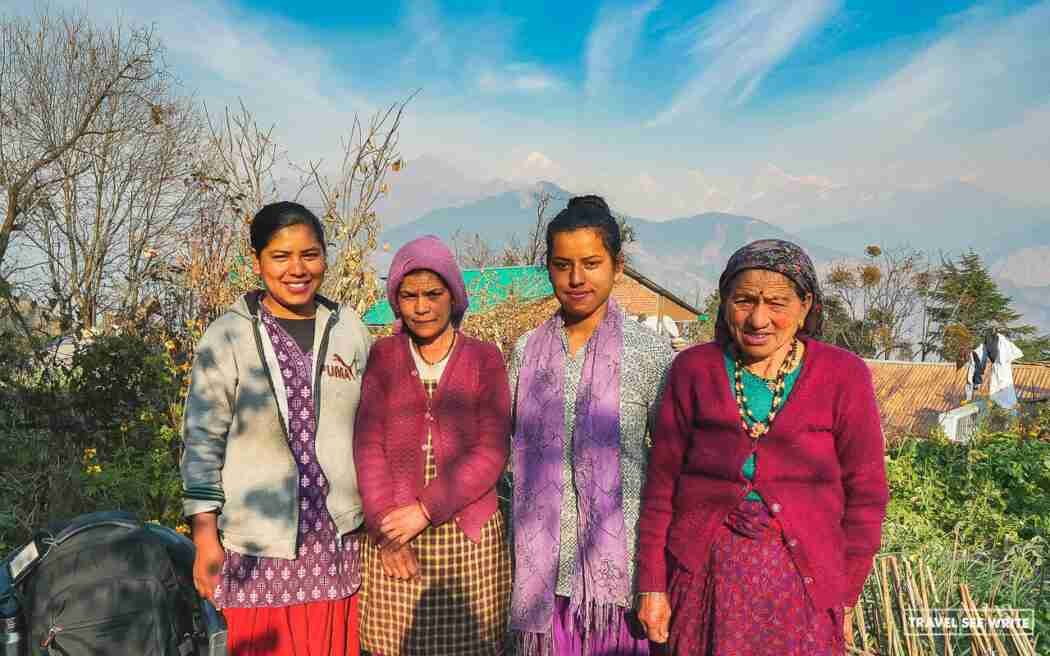




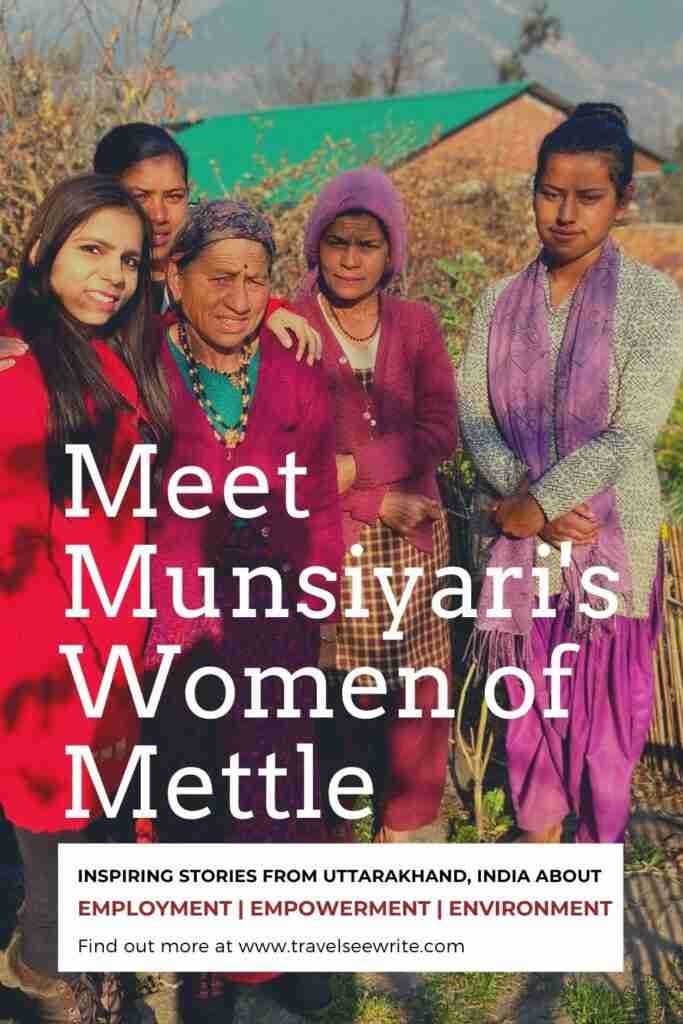
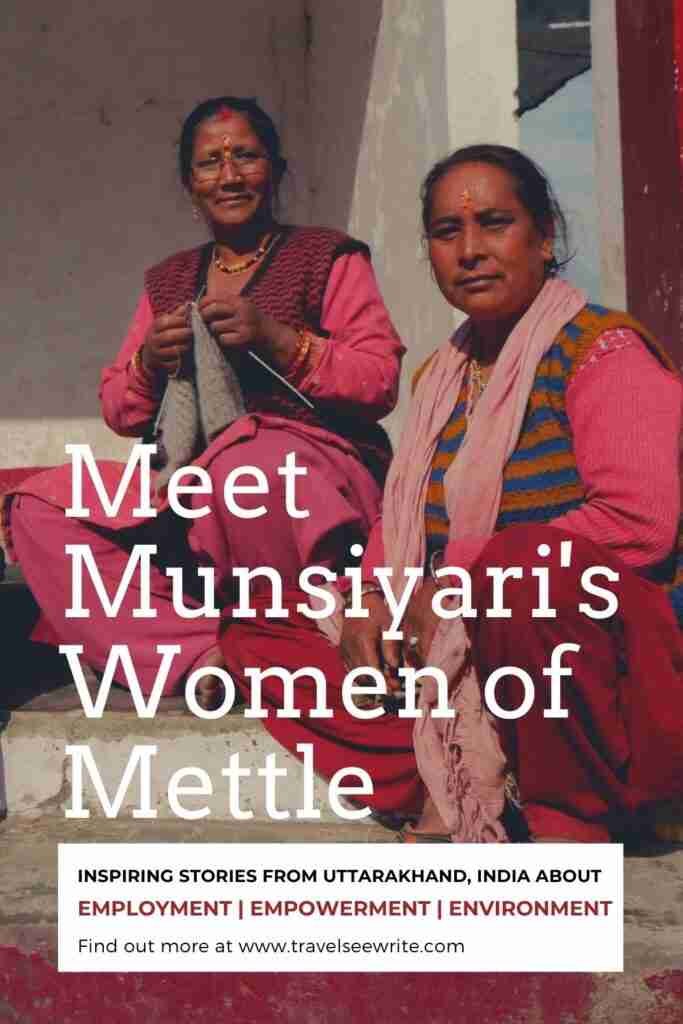
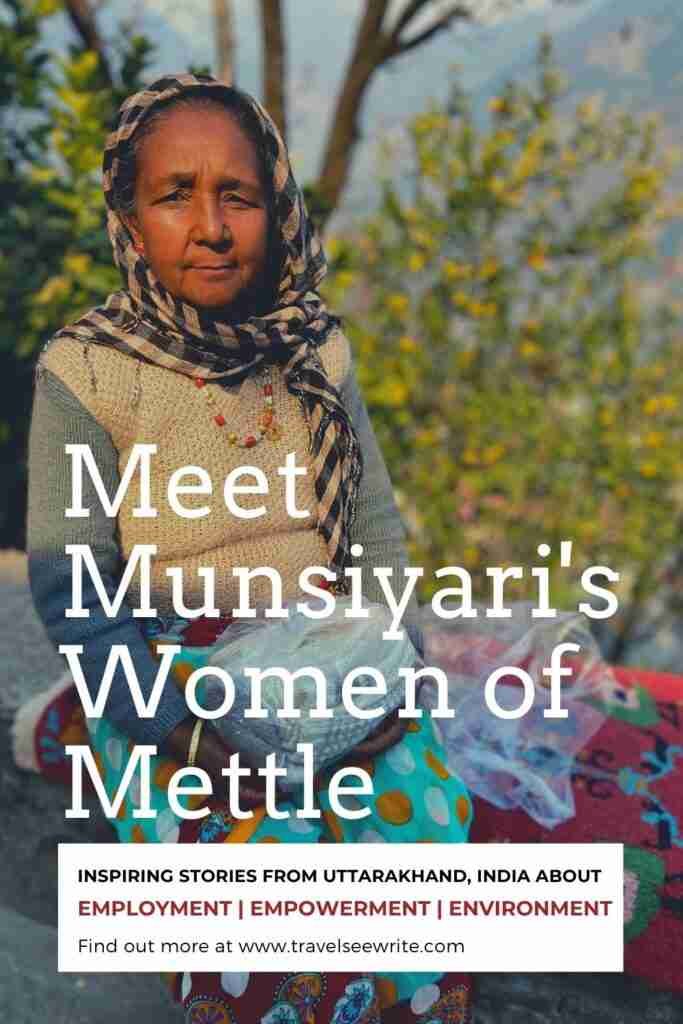
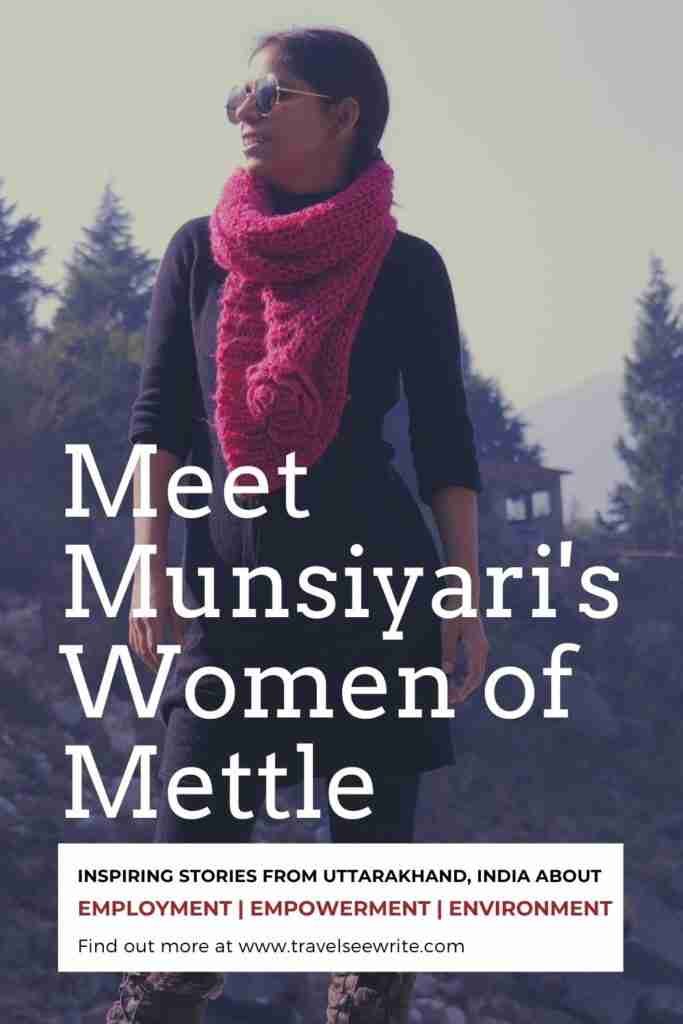




Your photographs are so beautiful! It’s also good that you featured the story of these ladies, it’s great to read a travel story from this perspective, unlike the usual guides and itineraries.
Thanks a lot. I am glad you liked the post.
Great to hear their story! Also very glad that there are efforts being done to improve ecotourism and livelihood in the area!
Thanks a lot for your thoughtful comment. Ecotourism can really solve a lot of social problems too.
Those villages look so sad but I’m glad that these women have found a way to make it work!
These women are truly the women of Mettle
I am not surprised that the Woman of Mettle are strong and versatile women. There is much we can learn from them.
Absolutely. Couldn’t agree more.
I am staying in India for almost 4 years now. But there is so many places i still not visiting. I wish to someday visit these ecotourism places and see how beautiful it is.
This is such an interesting article! I had no idea, thanks for sharing!
This is the first time I heard about Uttarakhand. It looks like a serene place. I need to visit it soon.
India has so many hidden gems, too bad migration is increasing. The next generation may not enjoy the wonders of uttarkhand since they have left the place long ago.
Hi, what a beautiful country and I love your images. Sad to see the Angora rabbits in such small cages. Hopefully, I can visit it one day.
This is true we all need to save these places, and by helping out homestays, we can try to put a check on migration in our own way. pahadi women are not only hardworking but they are fighters too, in there own way. I will be visiting Munsiyarri once the things cool down, will definitely book one of these home stays.
Life in the mountains is difficult, people enjoy being in the mountains for few days and feel things are so easy, but in reality, those people are living apart from their families and facing everyday issues all alone. It’s great that someone took an initiative and wrote about them, you did a wonderful job. Thank you
I love all of these empowered stories, thank you for sharing.